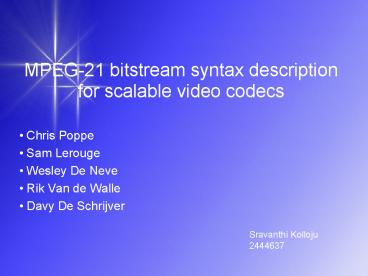MPEG21 bitstream syntax description for scalable video codecs PowerPoint PPT Presentation
1 / 14
Title: MPEG21 bitstream syntax description for scalable video codecs
1
MPEG-21 bitstream syntax description for scalable
video codecs
- Chris Poppe
- Sam Lerouge
- Wesley De Neve
- Rik Van de Walle
- Davy De Schrijver
Sravanthi Kolloju 2444637
2
Introduction
- Cell phones and PDA s are capable of running
video files - But both of them have dissimilar characteristics
in terms of memory processing power and
bandwidth. - So for every device there is need of using
different bitstream for video broadcast.
3
Main Idea
- Multichannel Publication Environment.
- MPEG-21 Bitstream Syntax Description language
(BSDL). - Creates high-level XML description of the
structure of the bitstream.
4
Bitstream Syntax description language(BSDL)
- MPEG-21 is build around one central concept
called - Digital Item (DI)
- BSDL belongs Digital Item Adaptation (DIA)
- DIA consists of several tools like
- Bitstream Syntax Description (BSD)
- Bitstream Schema
5
Related Work
- Another language used for multimedia
representation is FLAVOR (Formal Language for
Audio-Visual Object Representation. - FLAVOR code describes structure of a bit
stream and this code can in turn be translated
into C or Java. - FLAVOR which supports XML features is known as
XFLAVOR. - MPEG video mark up language is a description
language that has the same functionality of
XFLAVOR .
6
Scalable video coding
- There are different types of video coding
used for different applications - Fully scalable video coding MC-EZBC This coding
consists of all the information of original video
stream. - Temporal scalability Is used to achieve a video
- with lower frame rate.
- Spatial scalability Is used to achieve a video
with lower resolution. - SNR scalability Is used to achieve lower
bitrate
7
Fully Scalable Video Coding
- In this picture decomposition is done by
dividing in to - low frequency frames and high frequency frames.
8
Structure of a MC-EZBC bitstream
- The header consists of general information about
the bitstream. - The general bitstream consists of header and
payload. - Payload contains sizes of GOPs following the
actual GOPs structure.
9
Bitstream to XML
- Based on the bitstream BS Schema is generated.
- The corresponding XML code is created by making
use of - BintoBsd and BSSchema.
- lt?xml version1.0gt
- ltBitstream namespacegt
- ltheadergt
- ltNUMBER_GOPsgt
- ltGOPSIZEgt
- ltGOPgt
- ltGOPgt
- .
- .
- lt/Bitstreamgt
10
Adaptation of Temporal Scalability
- By using temporal scalability a video with a
lower frame - rate is obtained.
- The lower frame rate is obtained by eliminating
eight - high frequency frames in fully scalable video
coding. - H frames can be eliminated by removing the
highest - content tag in each GOP tag.
11
Spatial Scalability
- A lower resolution video frame is obtained by
using Spatial Scalability. - This is obtained by eliminating highest subbands
of each substream.
SNR Scalability
- A bitstream with a lower bit rate is generated
with SNR - Scalability.
- The encoding process in SNR scalability
delivers a - compressed bit stream and also a file
containing - information about the bit planes of different
subbands.
12
Conclusion
- Coding format-independent adaptation frame work
for binary media resources is discussed. - To evaluate the performance of the BSDL
framework, bitstreams encoded by two different
coding schemata were discussed. - Various scalability methods are achieved by
adaptive XML.
13
References
- Vetro, A., Christopoulos, C., Ebrahimi, T. From
the guest editors - Universal multimedia access. IEEE Signal
Process. Mag. 20(2), - 16 (2003)
- ISO/IEC 21000-72004 Information
technologymultimedia - framework (MPEG-21)Part 7 Digital Item
Adaptation (2004) - Mukherjee, D., Wang, H., Said, A., Liu, S.
Format-Agnostic - adaptation using the MPEG-21 DIA framework. In
Proceedings - of SPIE Annual Meeting 2004 Signal and Image
Processing and - Sensors. Denver, vol. 5558, pp. 351362 (2004)
- Devillers, S., Timmerer, C., Heuer, J.,
Hellwagner, H. Bitstream - syntax description-based adaptation in streaming
and constrained - environments. IEEE Trans. Multimedia 7(3),
463470 (2005) - Burnett, I., Van de Walle, R., Hill, K., Bormans,
J., Pereira, F. - MPEG-21 Goals and achievements. IEEE Multimedia
10(4), 60 - 70 (2003) Amielh,M., Deviller, S. Bitstream
Syntax Description Language - Application of XML-schema tomultimedia content
adaptation. In - Proceedings of the 11th International WWW
Conference. Honolulu, - Hawaii (2002)
- Duckett, J., Ozu, N., Williams, K., Mohr, S.,
Cagle, K., Graffin,
14
- Thank You

